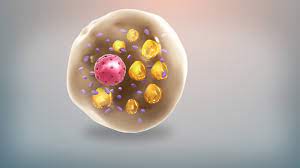How Your Health is Affected by Brown and White Fat
 Body fat is far more complex than most people realize. Most people understand that body fat is intended for the storage of calories.
Body fat is far more complex than most people realize. Most people understand that body fat is intended for the storage of calories.
They also know that it keeps us warm and that too much body fat is unhealthy. Other than that, most people draw a blank regarding the importance of Body Fat. The last decade of research has brought about tremendous gains in knowledge regarding the various functions and purposes of body fat.
What Is Fat?
Scientists refer to body fat as adipose tissue. Individual fat cells are called adipocytes. Researchers have had several breakthroughs in understanding how fat works in recent years. Around 1990, fat was understood to be a means to store calories. It's taken over a generation of research to truly show an appreciation of what fat does for the human body.
Fatty tissue is highly differentiated, with different fat types and other cells carrying various functions. This tissue is essential to blood sugar control and immunity, among several other critical tasks. Fat is commonly divided into two categories—subcutaneous fat and visceral fat. Subcutaneous fat is the layer of fat just underneath the skin.
Visceral fat covers and protects vital organs and is internal. Furthermore, adipose tissue can also be divided into brown fat and white fat, and there are also nerve endings, blood vessels, fibroblasts, and immune cells within adipose tissue.
White Fat vs. Brown Fat
Two essential types of fat that scientists are learning a lot about these days are white fat and brown fat. White fat performs the function most people think about when they think about fat. The primary purpose of white fat is to take calories and convert them into triglycerides for storage. Brown fat, on  the other hand, consumes calories to keep us warm. Brown adipose fat takes triglycerides and glucose and converts them into heat energy.
the other hand, consumes calories to keep us warm. Brown adipose fat takes triglycerides and glucose and converts them into heat energy.
Learning More about Brown and White Fat
The human body is comprised of significantly more white fat than brown fat. White fat is critical to Hormone Balance and reproductive function. It is capable of converting Testosterone into Estrogen. This is one of the dangers of obesity for men.
Excess fat leads to lower Testosterone and too much Estrogen. Too much adipose fat contributes to chronic inflammation, fatty liver disease, hypertension, and insulin resistance.
We have the highest proportion of brown fat at birth. Brown fat produces heat which protects the health of the child. Brown fat proportion declines as we age and is primarily found in the abdomen, the upper back, the shoulders, and the neck.
Research shows that brown fat is beneficial to metabolism. Activating brown fat has many benefits and can help ward off obesity and maintain leaner body mass.
One of the big debates right now is whether it's possible to convert white fat into brown fat (or brown into white). This process is known as transdifferentiation. Scientists have discovered beige cells which can change and adapt to circumstances, taking on the characteristics of brown fat or white fat as needed.
Body Fat and Obesity
Furthermore, we're not stuck with our original fat cells. They burn out and rotate. White fat can overdose on triglycerides which shorten their life cycle. A person's ability to gain and lose weight is related to caloric intake and how readily their fat white cells can store or burn calories. Though we know that white adipose cells live for around fifteen years, we don't yet understand the life cycle of brown fat.
There is a wide range of factors that contribute to obesity. The risk of obesity has a significant genetic factor, but lifestyle plays a central role. Our bodies produce various hormones to control and modulate hunger and body fat, including Leptin, Ghrelin, Human Growth Hormone, Insulin, and more.
 Insulin transports glucose for storage, and research shows that HGH helps unlock the energy stored in calories when not relying directly on food for energy.
Insulin transports glucose for storage, and research shows that HGH helps unlock the energy stored in calories when not relying directly on food for energy.
It's common for some people to gain weight when they take certain antidepressants or birth control. Individual physiology impacts patients differently.
Studies Explore Benefits of Brown Fat Activation
While the proliferation of fat white cells can lead to various health risks and dangers, growing evidence is that increasing brown fat volume can benefit health. Activated brown fat has been shown to lead to improved cholesterol, lower blood sugar, and less insulin resistance.
People with more brown fat are less prone to cardiovascular disease and are less likely to suffer from hypertension. If these studies continue to show success, we may be able to manipulate Brown Fat to improve blood pressure, balance cholesterol, and treat inflammation.
Contact us for a FREE, no-obligation discussion about the benefits of Human Growth Hormone (HGH) Replacement Therapy.
- 0001 Xylitol is a Natural, Plant-Sourced and Low-Calorie Sweetener [Last Updated On: January 8th, 2025] [Originally Added On: January 12th, 2021]
- 0002 The Secret Behind Keeping the Weight Off for Good -- No More Losing and Gaining Cycles! [Last Updated On: January 17th, 2025] [Originally Added On: January 13th, 2021]
- 0003 The Cognitive Benefits of Starting a CoQ10 (Coenzyme Q10) Supplement Regimen [Last Updated On: January 12th, 2025] [Originally Added On: January 14th, 2021]
- 0004 It's Time to Understand Why Vitamin C is Critical for Our Health and Longevity! [Last Updated On: January 10th, 2025] [Originally Added On: January 15th, 2021]
- 0005 Snoring is the Most Common Early Symptom of Sleep Apnea -- Do You Suffer From It? [Last Updated On: January 11th, 2025] [Originally Added On: January 16th, 2021]
- 0006 Vitamin-d Longevity Vitamin [Last Updated On: January 2nd, 2025] [Originally Added On: January 17th, 2021]
- 0007 Twenty Simple Weight Loss Tips That Can Change Your Life [Last Updated On: January 1st, 2025] [Originally Added On: January 18th, 2021]
- 0008 Twelve Ways To Control Cravings [Last Updated On: February 22nd, 2025] [Originally Added On: January 19th, 2021]
- 0009 The Truth About The Zone Diet [Last Updated On: January 1st, 2025] [Originally Added On: January 20th, 2021]
- 0010 The Truth About The Schwarzbein Principle [Last Updated On: December 31st, 2024] [Originally Added On: January 21st, 2021]
- 0011 The Truth About The Realage Diet [Last Updated On: December 31st, 2024] [Originally Added On: January 22nd, 2021]
- 0012 The Truth About The Origin Diet [Last Updated On: December 30th, 2024] [Originally Added On: January 23rd, 2021]
- 0013 The Truth About The Eat Right, Live Longer Diet -- Nourishing Food Equals Increased Longevity [Last Updated On: January 31st, 2025] [Originally Added On: January 24th, 2021]
- 0014 The Essential Roles Magnesium Plays For Our Energy Levels, Skin Youthfulness and Mental Health [Last Updated On: January 4th, 2025] [Originally Added On: January 25th, 2021]
- 0015 The Real Skinny On Vitamin B12. What It Can And Cannot Do For You [Last Updated On: March 23rd, 2025] [Originally Added On: January 26th, 2021]
- 0016 The Importance And Purpose Of Stress [Last Updated On: February 18th, 2025] [Originally Added On: January 27th, 2021]
- 0017 The Ideal Balanced Diet The Reality Of Healthy Eating [Last Updated On: December 30th, 2024] [Originally Added On: January 28th, 2021]
- 0018 The Effects Of Cortisol On The Body [Last Updated On: April 27th, 2025] [Originally Added On: January 29th, 2021]
- 0019 Sixteen Common Foods That Increase The Cancer Risk [Last Updated On: December 29th, 2024] [Originally Added On: January 30th, 2021]
- 0020 Should You Consider Intermittent Fasting? [Last Updated On: November 24th, 2024] [Originally Added On: January 31st, 2021]
- 0021 Can Caloric Restriction Help You Lose Weight And Live Longer? [Last Updated On: November 24th, 2024] [Originally Added On: February 1st, 2021]
- 0022 How Does Poor Sleep Rob Vitality And Health? [Last Updated On: November 24th, 2024] [Originally Added On: February 2nd, 2021]
- 0023 Nine More Natural Ways To Relieve Anxiety [Last Updated On: November 24th, 2024] [Originally Added On: February 3rd, 2021]
- 0024 Metabolism Boosting Tips For Losing Weight And Feeling Great [Last Updated On: October 13th, 2025] [Originally Added On: February 4th, 2021]
- 0025 Juicing Pros And Cons [Last Updated On: March 22nd, 2025] [Originally Added On: February 5th, 2021]
- 0026 Insomnia Guide [Last Updated On: October 12th, 2025] [Originally Added On: February 6th, 2021]
- 0027 How To Lose Weight With Human Growth Hormone [Last Updated On: October 11th, 2025] [Originally Added On: February 7th, 2021]
- 0028 How Safe Is Monosodium Glutamate AKA Msg? [Last Updated On: November 23rd, 2024] [Originally Added On: February 8th, 2021]
- 0029 How Is Sleep Apnea Diagnosed And Treated [Last Updated On: October 9th, 2025] [Originally Added On: February 9th, 2021]
- 0030 Hidden Sources Of Sugar In Common Foods [Last Updated On: October 8th, 2025] [Originally Added On: February 10th, 2021]
- 0031 How Would You Like to Potentially Add 14 Healthy and Youthful Years to Your Life Span? [Last Updated On: October 10th, 2025] [Originally Added On: February 11th, 2021]
- 0032 Four Reasons Why Healthy Sleep Encourages Weight Loss [Last Updated On: October 7th, 2025] [Originally Added On: February 12th, 2021]
- 0033 Omega-3 Fatty Acid Facts And How They Relate To Hormone Replacement Therapy [Last Updated On: April 24th, 2025] [Originally Added On: February 14th, 2021]
- 0034 Drink Right To Live Well [Last Updated On: October 6th, 2025] [Originally Added On: February 15th, 2021]
- 0035 Consumers Of Processed Meat Put Themselves At Risk [Last Updated On: October 5th, 2025] [Originally Added On: February 16th, 2021]
- 0036 Comparing The Same Mass Of Muscle And Fat [Last Updated On: February 19th, 2025] [Originally Added On: February 17th, 2021]
- 0037 Watermelon Health Food? The Benefits Of L-citrulline And Watermelon [Last Updated On: October 4th, 2025] [Originally Added On: February 18th, 2021]
- 0038 Alcohol Appears To Impact Sperm Quality [Last Updated On: October 3rd, 2025] [Originally Added On: February 19th, 2021]
- 0039 The Benefits of Selenium - Should You Take a Selenium Supplement? [Last Updated On: February 9th, 2025] [Originally Added On: April 8th, 2021]
- 0040 Selenium and its Impact on Your Health and Hormones [Last Updated On: March 3rd, 2025] [Originally Added On: April 8th, 2021]
- 0041 Scientifically Proven Benefits Of Turmeric The Indian Spice [Last Updated On: March 18th, 2025] [Originally Added On: April 27th, 2021]
- 0042 Natural Remedies for Heartburn or Acid Reflux [Last Updated On: February 18th, 2025] [Originally Added On: May 22nd, 2021]
- 0043 What the Heck Is a Raisin, Anyway and Why Would I Want to Eat One? [Last Updated On: May 18th, 2025] [Originally Added On: June 10th, 2021]
- 0044 Fat-Focused Diet May Help Boost Testosterone [Last Updated On: February 17th, 2025] [Originally Added On: June 10th, 2021]
- 0045 Chia Seeds: More Than Just a Fad [Last Updated On: April 11th, 2025] [Originally Added On: June 24th, 2021]
- 0046 Intermittent Fasting Boosts Growth Hormone, and Improves Cognitive Health [Last Updated On: March 4th, 2025] [Originally Added On: May 2nd, 2022]
- 0047 Growth Hormone, Nutrition, and Diet Affect Longevity [Last Updated On: February 14th, 2025] [Originally Added On: May 6th, 2022]
- 0048 Tesamorelin Boosts HGH Levels and Burns Belly Fat [Last Updated On: February 14th, 2025] [Originally Added On: May 21st, 2022]
- 0049 Build Muscle With Tofu - Don't Fear Soy [Last Updated On: December 29th, 2024] [Originally Added On: July 12th, 2022]
- 0050 Balancing HGH Levels with Weekly Sogroya [Last Updated On: December 28th, 2024] [Originally Added On: September 1st, 2022]
- 0051 Pecans Are Amazing [Last Updated On: February 19th, 2025] [Originally Added On: November 22nd, 2022]
- 0052 The Benefits of Fenugreek [Last Updated On: September 5th, 2025] [Originally Added On: November 24th, 2022]
- 0053 The Foods To Eat To Increase Stem Cells [Last Updated On: March 6th, 2025] [Originally Added On: December 7th, 2022]
- 0054 The Versatility of Pecans [Last Updated On: February 19th, 2025] [Originally Added On: February 9th, 2025]
- 0055 Understanding The Concept: A Pound Of Muscle Vs. A Pound Of Fat [Last Updated On: February 19th, 2025] [Originally Added On: February 11th, 2025]
- 0056 The Aging Enigma: Unravelling the Web of Human Growth Hormone Decline [Last Updated On: February 17th, 2025] [Originally Added On: February 12th, 2025]
- 0057 Rekindling the Flame: How a Fat-Friendly Diet Can Ignite Testosterone Levels [Last Updated On: February 14th, 2025] [Originally Added On: February 13th, 2025]
- 0058 Unlocking Your Inner Fountain of Youth: The Magic Elixir of HGH Injections for Women [Last Updated On: February 17th, 2025] [Originally Added On: February 14th, 2025]
- 0059 Effective Strategies for Controlling Cravings [Last Updated On: February 17th, 2025] [Originally Added On: February 17th, 2025]
- 0060 Overview of Hormone Replacement Therapy and the Role of Intermittent Fasting [Last Updated On: February 22nd, 2025] [Originally Added On: February 22nd, 2025]
- 0061 Understanding the Power of Stem Cells [Last Updated On: February 24th, 2025] [Originally Added On: February 24th, 2025]
- 0062 The Role of Selenium in Health and Hormones [Last Updated On: February 26th, 2025] [Originally Added On: February 26th, 2025]
Word Count: 786






